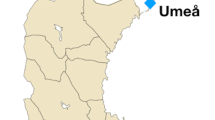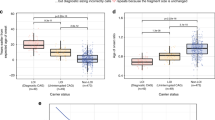Abstract
Careful comparison of symptomatic individuals with normal controls has revealed the primary biochemical abnormality in many human genetic diseases, particularly recessive disorders1. This strategy has proved less successful for most human disorders which are not recessive, and where a single copy of the aberrant gene has clinically significant effects even though the normal gene product is present. An alternative approach that eliminates the impediment of a normal protein in affected individuals is to study homozygotes for the mutant allele2. For virtually all dominant human disorders in which homozygotes have been described, symptoms have been significantly more severe in the homozygote than in the heterozygote3. Thus, these disorders do not conform to the classical definition of dominance which states that homozygotes and heterozygotes for a defect are phenotypically indistinguishable3–5. Instead, they display incomplete dominance, indicating that the normal allele may play a role in ameliorating the disease process. The D4S10 locus, defined by the probe G8 and linked to the gene for Huntington's disease (HD), has permitted us to identify individuals with a high probability of being homozygous for this autosomal dominant neurodegenerative disorder6–9. These homozygotes do not differ in clinical expression or course from typical HD heterozygotes. HD appears to be the first human disease of genetically documented homozygosity that displays complete phenotypic dominance.
This is a preview of subscription content, access via your institution
Access options
Subscribe to this journal
Receive 51 print issues and online access
$199.00 per year
only $3.90 per issue
Buy this article
- Purchase on Springer Link
- Instant access to full article PDF
Prices may be subject to local taxes which are calculated during checkout
Similar content being viewed by others
References
McKusick, V. A. Mendelian Inheritance in Man 6th edn (Johns Hopkins University Press, Baltimore, 1984).
Goldstein, J. L. & Brown, M. S. Am. J. med. 58, 147–150 (1975).
Pauli, R. M. Am. J. med. Genet. 16, 455–458 (1983).
Allison, A. C. & Blumberg, B. S. Am. J. med. 25, 933–941 (1958).
Hirschhorn, K. Am. J. med. Genet. 18, 541 (1984).
Gusella, J. F. et al. Nature 306, 234–238 (1983).
Gusella, J. F. et al. Nature 318, 75–78 (1985).
Gusella, J. F. et al. Science 225, 1320–1326 (1984).
Gusella, J. F. et al. Am. J. hum. Genet. 36, 139 (1984).
Negrette, A. Corea de Huntington, 2nd edn (La Editorial Universitaria, La Universidad del Zulia, Maracaibo, Venezuela, 1962).
Avila-Giron, R. in Advances in Neurology Vol. 1: Huntington's Chorea 1872–1972 (eds Barbeau, A., Chase, T. N. & Paulson, G. W.) 261–266 (Raven, New York, 1973).
Wexler, N. S. et al. Cytogenet. Cell Genet. 37, 605 (1984).
Wexler, N. S. & Wilentz, J. Report: Commission for the Control of Huntington's Disease and its Consequences, DHEW Pubn Nos NIH 78-1501 & 78-1502 Vol. I, 26–27 & Vol. II, 111–119 (1978).
Young, A. B. et al. Neurology 36, 244–249 (1986).
Shoulson, I. Neurology 31, 1333–1335 (1981).
Folstein, M. F., Folstein, S. E. & McHugh, P. R. J. Psychiat. Res. 12, 189–198 (1975).
Fisher, J., Kennedy, J., Caine, E. & Shoulson, I. in The Dementias (eds Mayeux, R. & Rosen, W.) 229–238 (Raven, New York, 1983).
Wexler, N. S. in Advances in Neurology, Vol. 23: Huntington's Disease (eds Chase, T. N., Wexler, N. S. & Barbeau, A.) 257–271 (Raven, New York, 1979).
Weingartner, H., Caine, E. D. & Ebert, M. H. J. abnorm. Psychol. 88, 52–58 (1979).
Joynt, R. J. & Shoulson, I. in Clinical Neuropsychology (eds Heilman, K. M. & Valenstein, E.) 475–502 (Oxford University Press, New York, 1979).
McHugh, P. R. & Folstein, M. F. in Psychiatric Aspects of Neurologic Disease (eds Benson, D. F. & Blumer, D.) 267–286 (Grune & Stratton, New York, 1975).
Folstein, S. E., Franz, M. L., Jensen, B. A., Chase, G. A. & Folstein, M. F. Psychol. Med. 13, 45–52 (1983).
Caine, E. D. & Shoulson, I. Am. J. Psychiat. 140, 728–733 (1983).
Edwards, J. A. & Gale, R. P. Am. J. hum. Genet. 24, 464–474 (1972).
Pauli, R. M. et al. Am. J. med. Genet. 16, 459–473 (1983).
Chemke, J. et al. J. med. Genet. 21, 173–177 (1984).
Hodgson, S. V. & Saunders, K. E. J. Med. Genet. 17, 478–480 (1980).
Nordstrom, S. & Thorburn, W. Clin. Genet. 18, 211–216 (1980).
White, R. A. H. & Akam, M. E. Nature 318, 567–569 (1985).
Bender, W. et al. Science 221, 23–29 (1983).
Lewis, E. B., Am. Zoologist 3, 33–56 (1963).
Shoulson, I. et al. Neurology 36 (suppl. 1), 176 (1985).
Shoulson, I. & Fahn, S. Neurology 29, 1–3 (1979).
Feinberg, A. P. & Vogelstein, B. Analyt. Biochem. 137, 266–267 (1983).
Anderson, M. A. & Gusella, J. F. In Vitro 20, 856–858 (1984).
Gusella, J. F. et al. Proc. natn. Acad. Sci. U.S.A. 76, 5239–5243 (1979).
Author information
Authors and Affiliations
Rights and permissions
About this article
Cite this article
Wexler, N., Young, A., Tanzi, R. et al. Homozygotes for Huntington's disease. Nature 326, 194–197 (1987). https://doi.org/10.1038/326194a0
Received:
Accepted:
Published:
Issue Date:
DOI: https://doi.org/10.1038/326194a0
This article is cited by
-
Mutant Huntingtin stalls ribosomes and represses protein synthesis in a cellular model of Huntington disease
Nature Communications (2021)
-
Mitochondrial Abnormalities and Synaptic Damage in Huntington’s Disease: a Focus on Defective Mitophagy and Mitochondria-Targeted Therapeutics
Molecular Neurobiology (2021)
-
Huntington’s Disease: Relationship Between Phenotype and Genotype
Molecular Neurobiology (2017)
Comments
By submitting a comment you agree to abide by our Terms and Community Guidelines. If you find something abusive or that does not comply with our terms or guidelines please flag it as inappropriate.



